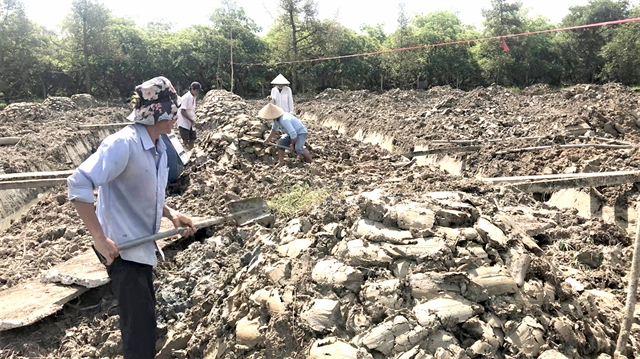 Opinion
Opinion


|
| Farmers of Chợ Lách District, the Mekong Delta Province of Bến Tre, work on the soil in early August this year after a damaging period of saline intrusion. — VNA/VNS Photo Công Trí |
Nguyễn Hữu Thiện, an independent expert on Mekong Delta ecology, talks to Nhân dân (People) online newspaper about measures to respond to the risk of the drought and salinity that are forecast to severely hit the delta at the beginning of the dry season next year.
The delta is forecast to be seriously hit by drought and salinity in the upcoming dry season between November 2020 and April 2021. What are the causes and what can you tell us about the situation?
The main reason for the low levels of flood water in the delta this year is the El Nino phenomenon that caused little rain in the whole basin between January and September. Moreover, severe drought has been occurring since early this year, causing tributaries of the Mekong River and hydro-power plants in the region to dry up. The first rains of this year had to fill the tributaries and plants before pouring into the river’s mainstream.
(The rainy season often starts in May and ends in October.)
The situation this year is quite different compared to last year. Last year, the El Nino phenomenon lasted until the end of the rainy season, so rainfall during the rainy season was very low. However, this year the La Nina phenomenon occurred in September. According to the United States’ National Oceanic and Atmospheric Administration, La Nina would last until the end of the rainy season. Therefore, there will be more rain and the water levels in the river and its tributaries will improve.
We believe that the drought and salinity in the dry season in 2021 will be harsh, but less severe than the last dry season.
This year, the provinces of Hậu Giang, Sóc Trăng, Bạc Liêu, Cà Mau and Kiên Giang will suffer less from drought and salinity in the dry season because water in the region mainly comes from rain instead of the Mekong River. Thanks to La Nina, these provinces will experience a lot of rain from now until the end of the year.
Authorities have proposed various solutions to cope with drought and salinity in the delta over the years, but the situation has not improved. Do you think these solutions have met the reality of the situation?
Some previous solutions are no longer suitable. The closer cultivation areas are to the sea and the river, the more at risk they are of facing a lack of fresh water. These areas will suffer more in extreme dry years. Salinity prevention will only be effective if cultivation areas are located further inland. Areas close to the sea should be converted to a rotational farming model following the two seasons of salt water and fresh water to avoid damage.
Additionally, the enclosed dykes upstream in the Long Xuyên Quadrilateral Region and Ðồng Tháp Mười (Plain of Reeds) are unsuitable now. The cultivation of three consecutive rice crops for many years has caused soil degradation and the need for more pesticide and fertiliser, leading to increased costs, reduced profits and polluted rivers.
Furthermore, the dykes block floodwater, worsening the situation during the rainy season and channelling the water out to sea, leading to fresh water shortages and increased saline intrusion during the dry season. If big floods occur and dykes are everywhere, the water will have nowhere to go, which could easily breach the dykes.
Another problem is a lack of investment for water works. Currently, water supplies for households in coastal areas often depend on irrigation and saline prevention facilities. Data showed that 95,000 households suffered from shortages this dry season. Moreover, the fresh water used inside saline prevention facilities is stagnant water, and should only be used for irrigation rather than household tap water.
Saline prevention facilities have a serious side effect, which is weaking the rivers and causing a lack of oxygen in the water so they lose the ability to self-clean and become "black rivers".
What measures are being taken in the short and long term to help the delta effectively adapt to drought and salinity?
In the short term, we need to closely monitor and adjust the crop calendar to avoid damage during years with extreme drought and salinity. The agricultural sector and farmers have already applied these measures. By adjusting the crop calendar, damage to rice fields during the 2020 dry season was much less than in 2016. For fruit orchards, we should use simple measures such as using large plastic bags to store water in canals at the end of the rainy season to irrigate the trees during the dry season.
The strategy should be divided into two categories. A strategy for long-term development should be based on the general drought and salinity experienced during normal years. Another strategy is needed to cope with extreme drought and salinity. The agricultural sector needs to boost its value by choosing better varieties, expanding the value chain, establishing brands and reaching higher-value markets.
International markets and the domestic market today have a higher demand for quality agricultural products. Consequently, low-value agriculture, focusing solely on quantity, is no longer suitable. Agricultural reform is the inevitable direction, as indicated in the Government’s Resolution No.120/NQ-CP (issued in 2017) on Sustainable and Climate-Resilient Development of the Mekong Delta.
We will not have to struggle with floods in the rainy season and drought in the dry season if we implement agricultural reforms following the seasons.
The remaining issue is to prioritise investment in the treatment of drinking water for local residents in coastal areas, and to separate it from saline prevention facilities for agriculture. — VNS




